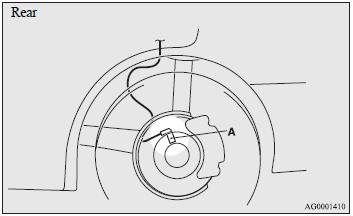Mitsubishi Outlander: Anti-lock brake system (ABS)
Environmental conditions can have an effect on braking. During sudden braking when there is snow, ice, oil, water etc. on the road surface, a skid may occur. In this situation, steering control and braking effectiveness is reduced and the stopping distance is increased. The vehicle may also go into an uncontrolled spin.
The ABS helps prevent the wheels from locking during braking, thus maintaining directional stability, ensuring controllability and providing optimum braking force.
Operating hints
● Always maintain the same distance from the vehicle in front of you as you would for a vehicle not equipped with ABS.
Compared with vehicles not fitted with ABS, your vehicle may require a longer stopping distance in the following cases:
• Driving on gravel or snow-covered roads.
• Driving with tyre chains installed.
• Driving on roads where the road surface is pitted or has other differences in surface height.
• Driving on bumpy roads or other poor driving surfaces.
● Operation of ABS is not restricted to situations where brakes are applied suddenly. This system may also operate to prevent wheel lock when you are driving over manholes, steel road-work plates, or the vehicle is driven over steps or level differences in the road, road markings, or other surfaces which are difficult for the wheels to grip.
● When the ABS is activated, you may feel the brake pedal pulsation and the vibrations of the vehicle body and steering wheel. You may also hear a characteristic noise. At this time, you may feel as if the pedal attempts to resist being depressed.
This is a normal result of the ABS operation, and does not indicate a problem.
If this situation occurs, depress the brake pedal more firmly in order to operate the ABS. Do not pump the brake. This will result in reduced braking performance.
● You will hear the operation sound of the motor coming from the engine compartment immediately following start off after starting the engine. If the brake pedal is depressed at that moment, a brake pedal pulsating is felt.
This pulsation is due to the self-diagnosis operation of the ABS and does not indicate a malfunction.
● The ABS becomes operative after the vehicle has accelerated to a speed in excess of about 10 km/h (6 mph). It stops operating when the vehicle decelerates to a speed below about 5 km/h (3 mph).
CAUTION:
● Even the ABS cannot prevent the natural laws of physics from acting on the vehicle. It cannot for instance avoid accidents that may result from excessive speed on bends or following another vehicle too closely or aquaplaning. It should remain the driver’s task to observe safety precautions to judge speeds and brake applications correctly in such conditions.
● Be sure to use tyres of the same type and size on 4 wheels.
If tyre types or sizes are mixed, ABS may not function normally.
● Never install a limited slip differential, which is not MITSUBISHI Genuine parts, as the ABS may not function normally.
We recommend you to consult a MITSUBISHI MOTORS Authorised Service Point.
ABS waning lamp / display

If there is a malfunction in the system, the ABS warning lamp will come on and “SERVICE REQUIRED” will appear on the information screen in the multi-information display.
Under normal conditions, the ABS warning lamp only comes on when the ignition switch is turned to the “ON” position and goes off a few seconds later.
CAUTION:
● Any of the following warning lamp/display behavior indicates that the ABS is not functioning and only the standard brake system is working (the standard brake system is functioning normally). If this happens, take your vehicle to a MITSUBISHI MOTORS Authorised Service Point.
• When the ignition switch is in the “ON” position, the warning lamp does not come on or it remains on and does not go off
• The warning lamp comes on while driving
• The warning display appears while driving
If the waning lamp / display illuminate while driving
If only the ABS warning lamp/display illuminate
Avoid hard braking and high-speed driving. Stop the vehicle in a safe place.
Restart the engine and check to see whether the lamp goes out after a few minutes driving; if it then remains off dur- ing driving, there is no problem.
However, if the lamp does not go out, or if it lights up again when the vehicle is driven, we recommend you to have the vehicle checked as soon as possible.
If the ABS waning lamp / display and brake waning lamp / display illuminate at the same time

The ABS and brake force distribution function may not work, so hard braking could make the vehicle unstable.
Avoid hard braking and high-speed driving. Stop the vehicle in a safe place and we recommend you to have the vehicle checked.
NOTE:
● The ABS warning lamp and brake warning lamp illuminate at the same time and the warning displays appear alternately on the information screen in the multi-information display.
After driving on icy roads

After driving on snowy roads, remove any snow and ice which may have become adhered to the wheel areas.
When doing this, be careful not to damage the wheel speed sensors (A) and cables located at each wheel on vehicles equipped with an ABS.


